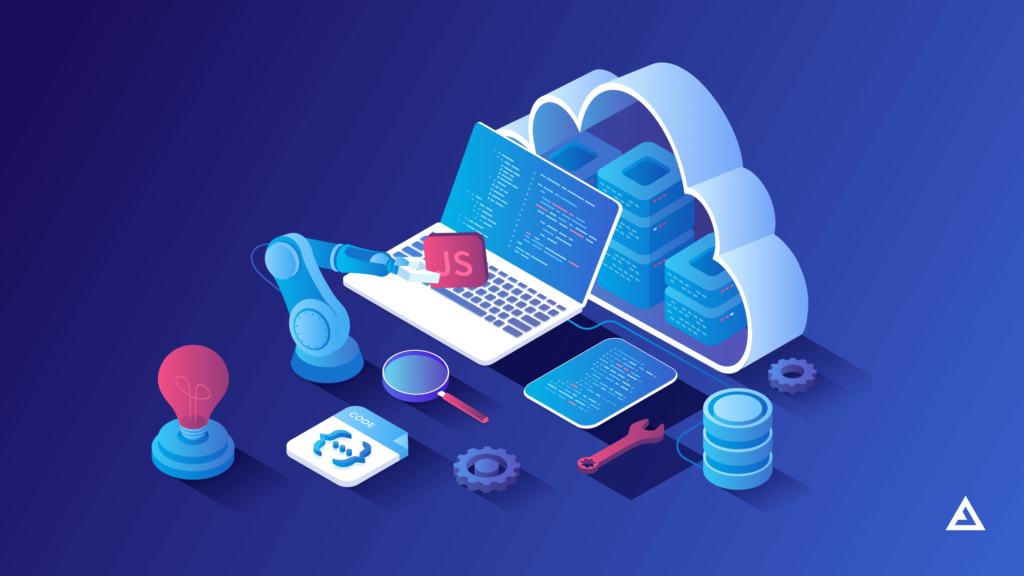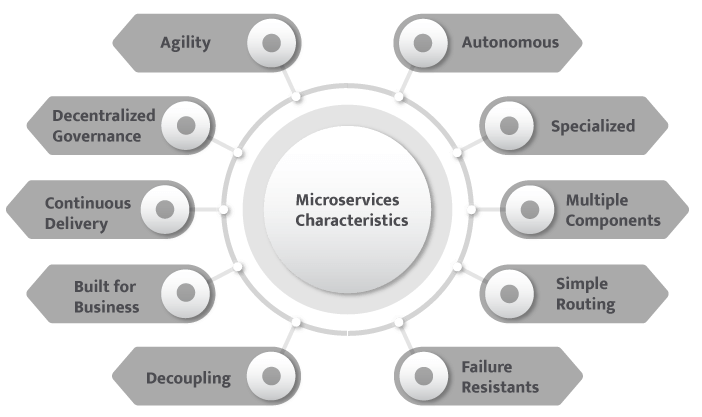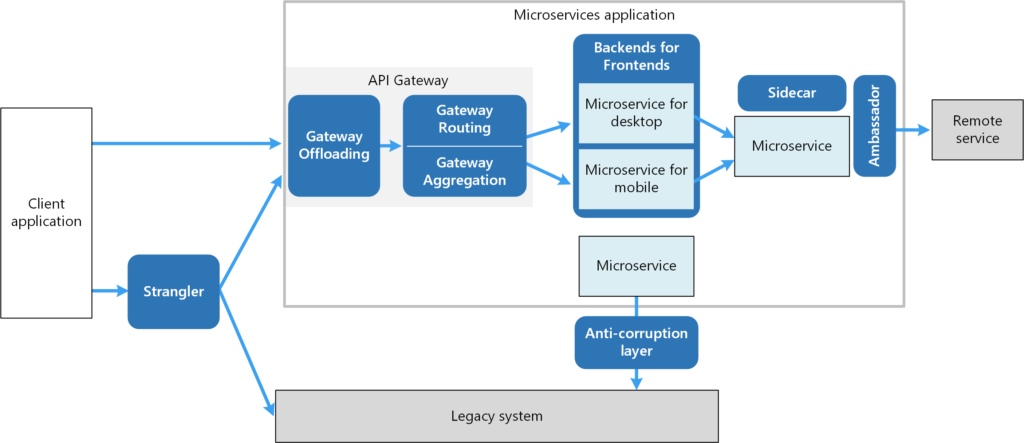What are Microservices, And What Are Their Benefits?

Microservices
What Are Microservices
Do you know What Are Microservices, if yes then this article is for you. We are discussing What Are Microservices Read on for more.
The microservice architecture is a design style where a large application is built as a suite of small independent services that are deployed and run in their own process.
These services can be written in any programming language, use different data storage technologies, and may communicate with each other via well-designed APIs.

The benefits of this approach are agility, decoupling, scalability and the ability to adapt to business needs.
Traditionally, enterprise applications are built in three main parts: client-side user interface (HTML pages and Javascript running on a browser), server-side domain logic and a central database. In a monolithic application, all these functions are a single tightly interdependent piece of software. Over time, it becomes a challenge to change even a small section of code as changes to the whole application must be made to deploy and test that code. A microservice application, , can be changed by modifying only one service and deploying that new version.
Microservices help solve key enterprise applications challenges including scalability, business agility, and profitability. The success of companies like Amazon, Netflix, and Uber demonstrates how microservices can be used to deliver these benefits.
Microservices aren’t without their challenges, but. It’s important to define a set of consistent standards that can be applied across teams when writing and testing microservices, as well as for developers to understand the impact of their changes on other services. Also addition, it can be difficult to manage and check the availability and performance of a complex microservices application.
Reasons for Using Microservice
There are several reasons why organizations choose to adopt microservices as their architectural approach. Here are some of the key reasons.
- Flexibility and Technology Diversity: Microservices enable teams to use different technologies, frameworks, and programming languages for different services. This flexibility allows developers to choose the most suitable tools for specific tasks, promoting innovation and avoiding technology lock-in. It also allows organizations to leverage existing technology investments and integrate new technologies as needed.

- Rapid Development and Deployment: Microservices architecture promotes decentralized development and deployment. Development teams can work independently on individual services, enabling faster development cycles. Since each service is relatively small and focused, it’s easier to understand, develop, test, and deploy them. This agility facilitates faster time-to-market and quicker response to changing business requirements.
- Fault Isolation and Resilience: Microservices are designed to be independent and loosely coupled. If a failure occurs in one service, it doesn’t necessarily affect the entire application. The fault is isolated to the specific service, allowing the rest of the application to continue functioning. This fault isolation improves system resilience, as failures are contained and don’t cascade to other services.
- Improved Maintainability: With microservices, each service has its own codebase and database, making it easier to understand, change, and maintain. Development teams can focus on specific services without worrying about the entire application. It also facilitates the adoption of agile development practices, such as continuous integration and continuous deployment, enabling faster bug fixes, updates, and feature enhancements.
- Organizational Scalability: Microservices architecture aligns well with the organizational structure, allowing different teams to work independently on different services. It promotes cross-functional teams, enables faster decision-making, and fosters a culture of autonomy and ownership. As the organization grows, new teams and services can be added without significant coordination overhead.
Benefits of Microservice
- Rapid Development and Deployment: Microservices architecture promotes decentralized development and deployment. Development teams can work independently on individual services, enabling faster development cycles. Since each service is relatively small and focused, it’s easier to understand, develop, test, and deploy them. This agility facilitates faster time-to-market and quicker response to changing business requirements.

- Improved Maintainability: With microservices, each service has its own codebase and database, making it easier to understand, change, and maintain. Development teams can focus on specific services without worrying about the entire application. It also facilitates the adoption of agile development practices, such as continuous integration and continuous deployment, enabling faster bug fixes, updates, and feature enhancements.
- Organizational Scalability: Microservices architecture aligns well with the organizational structure, allowing different teams to work independently on different services. It promotes cross-functional teams, enables faster decision-making, and fosters a culture of autonomy and ownership. As the organization grows, new teams and services can be added without significant coordination overhead.
- Improved Fault Tolerance: By using many small services instead of a monolithic architecture, the failure of a single service doesn’t bring down the entire system. Services can be designed to handle failures gracefully and provide fallback mechanisms, ensuring high availability and fault tolerance.
- Easier Integration and Continuous Delivery: Microservices communicate with each other through well-defined APIs. This makes it easier to integrate new services or third-party services into the omit system. Additionally, the modular nature of microservices facilitates continuous delivery practices, allowing organizations to deploy updates to specific services without impacting the entire application.
Limitations of Microservices
The microservices architecture style allows for development agility, reducing the time it takes to build and deploy an application. It also provides flexibility to update software, as microservices are small and self-contained. This helps to lower the chance of errors occurring when updates are performed, compared to monolithic applications.
But, this flexibility can introduce increased complexity, especially when the number of microservices grows. When each service has its own code base, dependencies can become entangled, leading to an increased likelihood of failure and instability. This can be problematic for the integrity of the system.
Additionally, if many services use the same database schema, changing one may break the other. So, it’s important to establish clear boundaries between each service to prevent the creation of a tightly coupled system.
Finally, microservices need a lot of communication between teams to keep up to date with their respective code bases and to ensure that each service is working correctly. This can be a significant burden on engineering teams, and it is important to find ways to streamline this process.
Examples of Microservices
Microservices can be found in various real-world applications. Here are a few examples of popular services or platforms that use microservices architecture:
- Netflix: Netflix is known for its extensive use of microservices. They have a highly scalable and fault-tolerant architecture consisting of hundreds of loosely coupled microservices. Each microservice handles a specific functionality, such as user authentication, content recommendation, search, streaming, and billing. This architecture allows Netflix to continuously innovate, scale rapidly, and deliver a personalized experience to millions of users.
- Amazon: Amazon, one of the largest e-commerce platforms, also adopts microservices architecture. They have a vast array of services, including user management, product catalog, inventory management, order processing, payment processing, and shipping logistics. Each service is independently developed, deployed, and scaled to ensure high availability and scalability.

- Uber: Uber, the ride-sharing platform, employs microservices to power its complex system. Different microservices handle various aspects, such as user management, real-time location tracking, trip routing, fare calculation, payment processing, and driver management. This allows Uber to scale rapidly and handle millions of rides daily while maintaining a seamless experience for users and drivers.
- : Twitter leverages microservices to handle its high-volume, real-time social media platform. Microservices are responsible for functions like user authentication, tweet storage, timeline generation, notifications, and trending topics. This architecture enables Twitter to handle massive traffic, provide real-time updates, and ensure system stability.
- Spotify: Spotify, the popular music streaming service, utilizes microservices to provide a personalized and seamless user experience. Their microservices handle functions such as user authentication, music catalog, playlist management, recommendation algorithms, and audio streaming. By employing microservices, Spotify can continuously deliver new features, handle millions of concurrent users, and tailor music recommendations to individual preferences.
Characteristics Of Microservices
- Service-Oriented: Microservices are designed around specific business capabilities or functions, representing small, independent services that encapsulate specific functionalities. Each microservice focuses on a specific task and handles a well-defined scope of functionality.

- Decentralization: Microservices architecture promotes decentralized development and deployment. Development teams can work independently on different services, using different technologies, languages, and frameworks. This enables teams to choose the most suitable tools for specific tasks, promotes innovation, and avoids dependencies on a single technology stack.
- Small and Focused: Microservices are small and focused on specific business capabilities. They aim to solve a specific problem or provide a distinct service. By keeping services small and focused, it becomes easier to understand, develop, test, and maintain them.
- Fault Isolation: Microservices are designed to be isolated from one another. If a failure occurs in one service, it does not necessarily affect the entire application. The fault is contained within the specific service, ensuring that other services continue to function properly. This fault isolation improves system resilience and minimizes the impact of failures.
- Continuous Delivery: Microservices architecture supports continuous delivery practices, enabling frequent and rapid deployment of updates. Services can be developed, tested, and deployed independently, allowing for faster bug fixes, feature enhancements, and iterative development.
- Distributed Development: Microservices architecture enables distributed development teams to work on different services simultaneously. This allows organizations to leverage the expertise of various teams and facilitates parallel development, resulting in faster time-to-market.
- Polyglot Persistence: Microservices architecture allows for different services to use different databases or data storage technologies that best suit their specific needs. This flexibility promotes polyglot persistence, where services can choose the most appropriate data storage mechanisms, such as relational databases, NoSQL databases, or in-memory caches.
Design Patterns of Microservices
- API Gateway: The API Gateway pattern provides a single entry point for client applications to interact with the microservices. It acts as a reverse proxy that handles requests, performs authentication and authorization, and routes them to the appropriate microservices. The API Gateway can also handle cross-cutting concerns like logging, monitoring, and caching.

- Circuit Breaker: The Circuit Breaker pattern helps in building resilient microservices that can handle service failures gracefully. It acts as a safety mechanism that monitors the availability of a service. If the service fails or becomes unresponsive, the circuit breaker trips and redirects requests to a fallback mechanism or returns an error response. This pattern prevents cascading failures and improves system stability.
- Event Sourcing: Event Sourcing is a pattern that involves capturing all changes to an application’s state as a sequence of events. Each microservice maintains its own event log, and the current state of the application is derived by replaying these events. This pattern allows for auditability, scalability, and rebuilding the state of microservices when needed.
- Saga Pattern: The Saga pattern is used to manage long-running and complex business transactions across many microservices. A saga is a sequence of local transactions, each executed by an individual microservice. If one of the steps fails, compensating actions are performed to revert the changes made by previous steps. This pattern ensures atomicity and consistency in distributed transactions.
- Command and Query Responsibility Segregation (CQRS): CQRS is a pattern that separates the read and write operations of an application into different services. Write operations are handled by the Command service, while read operations are handled by the Query service. This pattern allows for independent scaling, optimized data models for read and write operations, and improved performance for read-heavy applications.
Microservice Pros and Cons
Certainly! Here’s a table summarizing the pros and cons of microservices architecture:
| Pros of Microservices | Cons of Microservices |
| Enables scalability and independent service scaling | Increased complexity compared to monolithic architectures |
| Flexibility in technology selection and diversity | Higher operational overhead for managing and monitoring multiple services |
| Rapid development and deployment cycles | Service coordination and managing interactions between services can be challenging |
| Fault isolation and resilience | Data management complexities and ensuring data consistency across services |
| Improved maintainability and modularity | Performance overhead due to inter-service communication |
| Organizational scalability and autonomy | Testing and debugging complexities in a distributed environment |
| Improved fault tolerance and high availability | Deployment complexity and coordinating multiple services |
| Easier integration and continuous delivery practices | Organizational challenges in terms of coordination and communication |
It’s important to note that the pros and cons can vary depending on the specific context and requirements of an application or organization. While microservices offer many advantages, such as scalability, flexibility, and fault tolerance, they also introduce complexities that need to be carefully managed. Organizations should assess their specific needs, technical capabilities, and the trade-offs associated with microservices before making a decision.
Also Read About What is MongoDB – Working and Features
FAQ – What Are Microservices
Microservices are an architectural and organizational approach to software development where software is composed of small independent services that communicate over well-defined APIs. These services are owned by small, self-contained teams.
A microservices architecture is a type of application architecture where the application is developed as a collection of services. It provides the framework to develop, deploy, and maintain microservices architecture diagrams and services independently.
Microservice architecture, aka microservices, are a specific method of designing software systems to structure a single application as a collection of loosely coupled services. Applications tend to begin as a monolithic architecture (more on that below), and over time grow into a set of interconnected microservices.
Conclusion
The microservice architecture is a design style where a large application is built as a suite of small independent services that are deployed and run in their own process.
These services can be written in any programming language, use different data storage technologies, and may communicate with each other via well-designed APIs.
The benefits of this approach are agility, decoupling, scalability and the ability to adapt to business needs.
We hope that this article has helped you to know What Are Microservices, if you have any questions then let us know in the comment section.








1 thought on “What are Microservices, And What Are Their Benefits?”